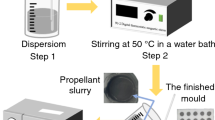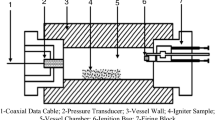Abstract
The burning rate of AN–HTPB-based propellant catalysed with chromium salt has been studied using conventional strand burner under the various pressure range, i.e. from atmospheric pressure to 6.897 MPa and verified with Piobert law, i.e. r = aP n. At atmospheric pressure, the burning rate AN–HTPB propellant was being accelerated with the chromium-based catalysts used. In case of lead chromate-catalysed system, burning rate was observed 2.655 times higher than burning rate (r = 0.200 mm s−1) of virgin AN–HTPB propellant sample. However, the Copper chromate-catalysed propellant burned with slower rate (r = 0.160 mm s−1) than the virgin AN–HTPB propellant sample. The burning rate of all catalysed propellant samples are found to be the pressure sensitive and accelerated higher with rise of pressure. The highest burning rate (r = 2.422 mm s−1) was recorded with ammonium dichromate and lowest (r = 1.40 mm s−1) with lead chromate-catalysed propellant sample with the rise of pressure up to 6.897 MPa at different pressures. A linear relationship was observed between the burning rate and pressure rise which followed the Piobert law, i.e. r = aP n. The pressure index (n) values of AN–HTPB-based samples were calculated higher when catalysed with ammonium dichromate, Copper Chromate, Cr2O3, Potassium dichromate (n = 0.525, 0.555, 0.429, and 0.408 respectively) and lower (n = 0.226) with lead chromate compared to virgin sample (n = 0.405). Higher value indicates the positive effect on accelerating the burning rate with catalyst at higher pressure ranges.



Similar content being viewed by others
References
Hamilton BK. Method for making a propellant having a relatively low burn rate exponent and high gas yield for use in a vehicle inflator, US Patent 6315930, Nov 2001.
Batchelder GW. Solid composite, smokeless, slow burning, low flame propellant, UP Patent 2974026, March 1997.
Jones JL. Smokeless slow burning cast propellant—ammonium nitrate, catalyst, methyl acrylate copolymer, US Patent 4112,849, Sept 1978.
Simoes P, Pedroso L, Portugal A, Plaksin I, Campos J. New propellant component part II. Study of a PSAN/DNAM/HTPB based formulation. Propellant Explos Pyrotech. 2001;26(6):278–83.
Arakawa Y, Kohga M. Combustion characteristics of ammonium nitrate based composite solid propellant: effect of mean diameter of ammonium nitrate. Kayaku Gakkaishi. 1997;58(2):76–82.
Arakawa Y, Kohga M. Ammonium nitrate based composite solid propellant 2: effects of addition of surfactants on viscosity of uncured propellant. Kayaku Gakkaishi. 1997;58(2):83–8.
Kuwahara T, Matsno S. Burning rate characteristics and ignition characteristics of ammonium nitrate/ammonium perchlorate composite propellants. Kayaku Gakkaishi. 1995;56(3):135–40.
Kato K, Goro N. Burning rate characteristics of GAP/AN propellant. Kayaku Gakkaishi. 1995;56(3):130–4.
Hagihara Y. Effects of chromium and cobalt compounds on burning rate of AN/HTPB composite propellant. Kogyo Kayaku (Sci Technol Energ Mater). 1991;52(6):390–395.
Kempa PB, Herrmann M, Engel W. Dilatometric measurement of phase stabilized ammonium nitrate (CuPSAN) performed by X-ray Diffraction. In: 29th international annual conference ICT, on energetic materials, 1998, p. 73.1–73.11.
Brewster MQ, Sheridan TA, Ishihara A. Ammonium nitrate–magnesium propellant combustion and heat transfer mechanisms. J Propuls Power. 1992;18(4):760–9.
Murata H, Azuma Y, Tohara T, Simoda M, Yamaya T, Hori K, Saito T. Effect of magnalium (Mg–Al Alloy) on combustion characteristics of ammonium nitrate based solid propellant. Kayaku Gakkaishi. 2000;61(2):58–66.
Backstead MV, Derr RL, Price CF. A model of composite solid propellant combustion based on multiple flame. AIAA J. 1970;8(12):2200–7.
Hermance CF. A model of composite propellant combustion including surface heterogeneity and heat generation. AIAA J. 1966;4(9):1629–37.
Fenn JB. A Phalanx flame model for the combustion of composite solid propellants. Combust Flame. 1968;12(3):201–16.
Andersen WH, Bills KW, Mishuck E, Moe G, Schultz RD. A model describing combustion of solid composite propellants containing ammonium nitrate. Combust Flame. 1959;3:301–17.
Chaiken RF. A thermal layer mechanism of combustion of solid composite propellants. Combust Flame. 1959;3:285–300.
Chaiken RF, Anderson WH. The role of binder in composite propellant combustion. Solid propellant rocket research, progress in astronautics and rocketry Vol. I. New York: Academic Press; 1960. p. 227–47.
Carvalheira P, Campos J. A combustion model for AN/HTPB-IPDI composite solid propellant. In: Proceeding of international conference on energetic materials-technology, manufacturing and processing, Institut Chemische Technologie, Germany, 1996, p. 12.1–12.21.
Kondrikov BN, Annikov VE, Egorshev VU, DeLuca L, Bronzi C. Combustion of ammonium nitrate-based compositions, metal-containing and water impregnated compounds. J Propuls Power. 1999;15(6):763–71.
Sarner SF. Propellant chemistry. New York: Reinhold Publishing Corporation; 1966.
Kadiresh PN, Sridhar BTN. Experimental study on ballistic behaviour of an aluminised AP/HTPB propellant during accelerated aging. J Therm Anal Calorim. 2010;100(1):331–5.
Yi J-H, Zhao F-Q, Ren Y-H, Wang B-Z, Zhou C, et al. BTATz-CMDB propellants, high-pressure thermal properties and their correlation with burning rates. J Therm Anal Calorim. 2011;104(3):1029–36.
Munjal NL, Joshi PC, Shrivastava BP. Burning rate studies of HTPB-AP composite solid propellants. National convention on Indian space programme for 2000 & beyond a prospective, BIT Mesra, India, Dec 1998, p. 197–215.
Rastogi RP, Syal V. Pressure dependence of catalysed and inhibited burning rate of composite solid propelants. Indian J Chem. 1989; 28A:452–7.
Varma M, Pandey M. Thermal decomposition studies on catalysed ammonium nitrate. In: Proceeding, HEMCE 2000, of the 3rd international convention on high energy materials, VSSC Trivendrum, India, 6–8 Dec, 2000, p. 182–188.
Author information
Authors and Affiliations
Corresponding author
Rights and permissions
About this article
Cite this article
Pandey, M., Jha, S., Kumar, R. et al. The pressure effect study on the burning rate of ammonium nitrate-HTPB-based propellant with the influence catalysts. J Therm Anal Calorim 107, 135–140 (2012). https://doi.org/10.1007/s10973-011-1718-z
Published:
Issue Date:
DOI: https://doi.org/10.1007/s10973-011-1718-z




